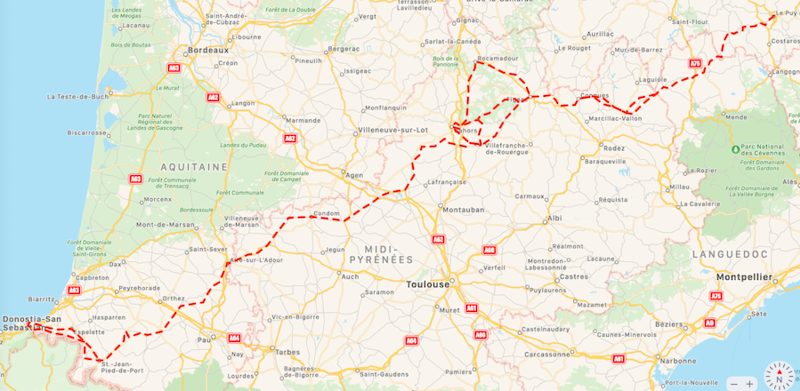When I first decided to walk the Camino de Santiago, I dutifully ordered the first guidebook I could find. It was harder in those days; the options were a lot more limited. I ended up with Alison Raju’s The Way of St James: Le Puy to Santiago. It’s something to marvel at today, that this compact book included BOTH the Camino Francés and the Via Podiensis. It even had a skeleton summary of the Via de la Plata at the end for good measure. How innocent everything was.
While my feet were leading me to the Camino Francés, my eyes kept bringing me back to a color photo of Estaing, a beautiful town on the Lot River on the Le Puy route. In the Montes de Oca, in the meseta, even in verdant Galicia, my attention kept drifting from those detailed turn-by-turn directions back to that photo of a powerful castle perched precipitously above tightly-packed medieval houses.

It would take me a decade to get there.
While that first visit was long-delayed, the reality lived up to the dream, and it has kept drawing me back. I head out this Friday for my fourth turn on the Via Podiensis. My last two pilgrimages from Le Puy have been with student groups, but I’ll be solo again this time around, and with a new purpose this time.
Alison Raju’s book brought me here. Now, with Alison’s passing, I return to carry her work forward, as I prepare a new edition of Cicerone’s guidebook to the Le Puy route (now appropriately separated from the Camino Francés!). This has been a completely different experience from my previous guidebook projects. First, it’s a totally solo experience, as Laura’s professional obligations preclude her participation. Second, because of the pandemic, I’ve been stuck at home with more time on my hands than normal. As a consequence, I’ve actually written out a full draft of the book, based on my old trip notes and gps tracks. There will inevitably be plenty to freshen up, but it’s exciting to have that framework in place as I hit the road.
Along with that, I’ve been working recently to build a spreadsheet tracking up-to-date accommodation information on the Le Puy route. For those walking this year, here’s a list of towns, accommodations, and email addresses. If the place has replied to my request for feedback, you’ll also see the host names and (where available) webpage. If no information is listed, it’s possible that the place has closed, but it’s more likely that they’re busy!
In the weeks ahead, I’ll rewalk (or, in a few cases, walk for the first time) everything that will be included in the book. Beyond the GR65 itself, that also includes the GR651 (the Célé Valley), the Rocamadour variant, a number of GR6 variants, the Bonneval detour, and two different approaches between Saint-Jean-Pied-de-Port and Hendaye (the GR10 and the low-level chemin).
The majority of pilgrims never spend more than one night in France–that first night in Saint-Jean-Pied-de-Port. However, those who branch out to Le Puy discover a pilgrimage experience that is wonderfully rich. The churches are all open, the gites are smaller and more comfortable, the meals are full of fresh ingredients and distinct cultural experiences unto themselves. Le Puy veterans come back, again and again. I’m thrilled to go back now.
3 thoughts on “Off to Le Puy!”
Comments are closed.



Hi, Dave!
I hope you’ ll enjoy the pilgrimage, the future book will be then better…
Some day it would be stupendous hear on your podcast a programm about monasteries: it is a beautifull and problematic history un Europe (specially in Spain): of course about religion
but also about man’ s work measure, social and ecológic armony and political tension between the ideas of burgues progress and eternity…
I appreciate the suggestion! I’m very interested in the subject, so an episode on monasteries is appealing. I’ll file that away for when I make it back to the podcast.
https://m.facebook.com/story.php?story_fbid=10213232326402893&id=1838336942
A text on my Facebook pague about monasteries and civilization